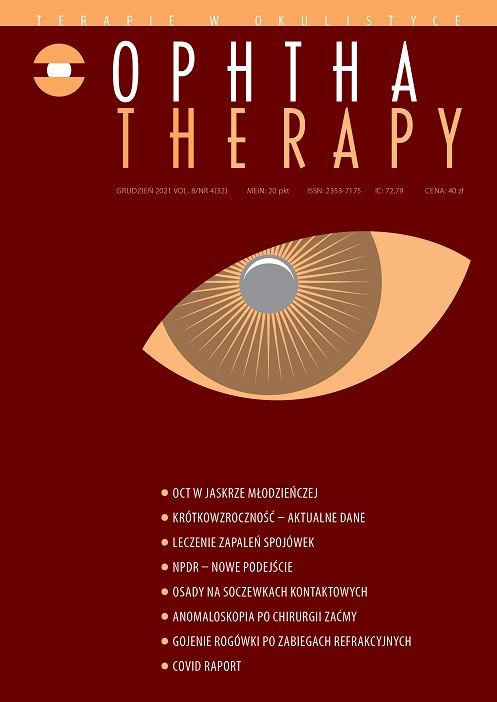The way it was and the way it should be – the new approach to the treatment of nonproliferative diabetic retinopathy Review article
Main Article Content
Abstract
Diabetes has been declared an epidemic of the XXIst century by the World Health Organisation. Diabetic retinopathy, one of its main complications, is a leading cause of vision impairment among professionally active adults. Diabetic retinopathy is a microangiopathy that affects mainly small vessels, due to their highest vulnerability to hyperglycemia. Preventive measures involve mainly strict diabetic follow-ups, balanced level of glycated hemoglobin, blood pressure values and analysis of lipids. Regular ophthalmological check-ups and imaging tests of the retina are also extremely significant. For many years scientists have searched for a therapy to suppress vascular changes in diabetes. In May 2021 a stance on sulodexide use as a supporting treatment in mild and intermediate diabetic retinopathy was published by the Polish Society of Ophthalmology. Sulodexide protects vascular endothelium, contributes to endothelial cells’ function and has profibrinolytic, anti-inflammatory and vasoregulatory properties. These features make it a promising protective agent in the early stages of diabetic retinopathy.
Downloads
Article Details

This work is licensed under a Creative Commons Attribution-NonCommercial-NoDerivatives 4.0 International License.
Copyright: © Medical Education sp. z o.o. License allowing third parties to copy and redistribute the material in any medium or format and to remix, transform, and build upon the material, provided the original work is properly cited and states its license.
Address reprint requests to: Medical Education, Marcin Kuźma (marcin.kuzma@mededu.pl)
References
2. Song JH, Chin HS, Kwon OW et al; DRESS Research Group. Effect of sulodexide in patients with non-proliferative diabetic retinopathy: diabetic retinopathy sulodexide study (DRESS). Graefes Arch Clin Exp Ophthalmol. 2015; 253(6): 829-37. http://doi.org/10.1007/s00417-014-2746-8.
3. Misiuk-Hojło M, Jędrzejczyk R, Wodzisławska M. Farmakoterapia w leczeniu wczesnych stadiów retinopatii cukrzycowej – przypadki pacjentów. Przegląd Okulistyczny. 2020; 2(90): 8-10.
4. Charakterystyka produktu leczniczego Vessel Due F.
5. Wong TY, Sun J, Kawasaki R et al. Guidelines on Diabetic Eye Care: The International Council of Ophthalmology Recommendations for Screening, Follow-up, Referral, and Treatment Based on Resource Settings. Ophthalmology. 2018; 125(10): 1608-22. http://doi.org/10.1016/j.ophtha.2018.04.007.
6. Kański JJ, Bowling B. Okulistyka kliniczna. 7th ed., Edra Urban & Partner / Elsevier, 2013: 531-7.
7. Bressler SB, Glassman AR, Almukhtar T et al. Diabetic Retinopathy Clinical Research Network. Five-Year Outcomes of Ranibizumab With Prompt or Deferred Laser Versus Laser or Triamcinolone Plus Deferred Ranibizumab for Diabetic Macular Edema. Am J Ophthalmol. 2016; 164: 57-68. http://doi.org/10.1016/j.ajo.2015.12.025.
8. The Diabetic Retinopathy Study Research Group; Photocoagulation treatment of proliferative diabetic retinopathy: A short report of long range results., Diabetic Retinopathy Study (DRS) Report Number 4. Proceedings of the 10th Congress of the International Diabetes Federation 1979.
9. Zeng Y, Zhang XF, Fu BM et al. The Role of Endothelial Surface Glycocalyx in Mechanosensing and Transduction. Adv Exp Med Biol. 2018; 1097: 1-27. http://doi.org/10.1007/978-3-319-96445-4_1.
10. Broekhuizen LN, Lemkes BA, Mooij HL et al. Effect of sulodexide on endothelial glycocalyx and vascular permeability in patients with type 2 diabetes mellitus. Diabetologia. 2010; 53(12): 2646-55. http://doi.org/10.1007/s00125-010-1910-x.
11. Połubinska A, Staniszewski R, Baum E et al. Sulodexide modifies intravascular homeostasis what affects function of the endothelium. Adv Med Sci. 2013; 58: 304-10.
12. Ciszewicz M, Polubinska A, Antoniewicz A et al. Sulodexide suppresses inflammation in human endothelial cells and prevents glucose cytotoxicity. Trans Res. 2009; 153: 118-23.
13. Bręborowicz A. Sulodeksyd – mieszanina glikozaminoglikanów o protekcyjnym działaniu w stosunku do komórek śródbłonka naczyniowego. Acta Angiol. 2019; 20(3): 112-8.
14. Gaddi AV, Cicero AF, Gambaro G. Nephroprotective action of glycosaminoglycans: why the pharmacological properties of sulodexide might be reconsidered. Int J Nephrol Renovasc Dis. 2010; 3: 99-105.
15. Crepaldi G, Fellin R, Calabrò A et al. Preliminary results of sulodexide treatment in patients with peripheral arteriosclerosis and hyperlipidemia. A multicentre trial. Monogr Atheroscler. 1986; 14: 215-21.
16. Ward BJ, Donnelly JL. Hypoxia induced disruption of the cardiac endothelial glycocalyx: implications for capillary permeability. Cardiovasc Res. 1993; 27: 384-9.
17. Paneni F, Beckman JA, Creager MA et al. Diabetes and vascular disease: pathophysiology, clinical consequences, and medical therapy: part I. Eur Heart J. 2013; 34(31): 2436-43. http://doi.org/10.1093/eurheartj/eht149.
18. Serwatka A, Grabska-Liberek I, Tesla P. Sulodeksyd – możliwości zastosowania u pacjentów z retinopatią cukrzycową. Okulistyka. 2017; 1: 74-6.
19. Carroll BJ, Piazza G, Goldhaber SZ. Sulodexide in venous disease. J Thromb Haemost. 2019; 17(1): 31-8. http://doi.org/10.1111/jth.14324.

